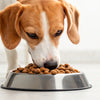Do Dogs Have to Eat Kibble? Exploring the Best Nutrition for Our Canine Companions
- Houndsy
Table of Contents
- Introduction
- Understanding Dog Nutrition
- The Rise of Alternative Diets
- Comparing Kibble, Fresh Food, and Raw Diets
- Making the Right Choice for Your Dog
- Conclusion
Introduction
As dog owners, we often find ourselves pondering the age-old question: Do dogs have to eat kibble? With a plethora of options available today, from fresh foods to raw diets, the landscape of dog nutrition is more complex than ever. In fact, recent studies suggest that our furry friends might thrive on a variety of diets that differ significantly from traditional kibble.
According to the American Kennel Club, a balanced diet is crucial for maintaining a dog's overall health and well-being. However, with the rise in popularity of fresh and homemade dog foods, many pet parents are left wondering whether kibble is still the best option for their beloved companions.
In this blog post, we will delve into the various dietary options available for dogs, exploring the pros and cons of kibble, fresh food, and raw diets. We aim to guide you in making informed decisions about your pet's nutrition. By the end, we hope you'll have a clearer understanding of what food is best suited for your dog’s individual needs, lifestyle, and preferences.
Understanding Dog Nutrition
The Basics of Canine Diet
Before we tackle the question of kibble, let’s first examine the essential nutritional components that every dog requires:
- Proteins: Essential for building and repairing tissues, proteins should ideally be the primary ingredient in your dog’s diet.
- Fats: These provide energy and support cell function. Healthy fats, such as omega-3 and omega-6 fatty acids, are vital for skin and coat health.
- Carbohydrates: While not essential, carbohydrates can provide dogs with energy and aid digestion when sourced from quality grains or vegetables.
- Vitamins and Minerals: These are crucial for various bodily functions, including immune response and bone health.
Each dog's nutritional needs will vary based on age, breed, size, activity level, and health condition. Consulting a veterinarian to determine the right balance for your pooch will always be beneficial.
The Role of Kibble in Dog Diets
Kibble, or dry dog food, has long been a staple in canine nutrition. Its convenience, long shelf life, and affordability make it an attractive option for busy pet owners. However, it’s essential to evaluate its nutritional value critically. High-quality kibble should contain:
- A named protein source as the first ingredient (e.g., chicken, beef)
- Whole grains or vegetables for carbohydrate content
- Essential vitamins and minerals
Not all kibble is created equal. Some brands use fillers, artificial preservatives, and low-quality ingredients that do not provide optimal nutrition. This discrepancy can lead to various health issues, including obesity and allergies.
The Rise of Alternative Diets
Fresh Food Diets
In recent years, fresh food diets have gained traction among dog owners. These diets often consist of human-grade ingredients that are minimally processed, offering a host of benefits:
- Nutritional Quality: Fresh food is typically more nutrient-dense and easier for dogs to digest. Ingredients like lean meats, fruits, and vegetables can provide a well-rounded diet.
- Improved Health and Vitality: Many owners report that their dogs exhibit increased energy levels, healthier skin and coat, and improved digestion when switched to fresh food.
- Customization: Companies like Houndsy offer customizable meal plans tailored to your dog’s specific needs, including age, weight, and activity level.
However, transitioning to a fresh food diet requires careful planning and may involve a higher cost compared to kibble. It’s crucial to ensure that these meals are balanced and meet AAFCO standards for complete nutrition.
Raw Food Diets
The raw food diet, or "BARF" (Biologically Appropriate Raw Food), advocates feeding dogs a diet that mimics what they would eat in the wild. This typically includes raw meat, bones, fruits, and vegetables. Proponents of this diet argue that it can lead to:
- Healthier Teeth and Gums: Chewing raw meat and bones can help in dental health.
- Improved Coat Quality: Many raw food advocates report shinier coats and healthier skin.
- Enhanced Energy Levels: Dogs on raw diets often exhibit increased vitality.
However, raw feeding comes with risks, including bacterial contamination and potential imbalances in nutrients. The American Veterinary Medical Association (AVMA) warns about the dangers of feeding raw diets without proper guidance from a veterinary nutritionist.
Comparing Kibble, Fresh Food, and Raw Diets
Nutritional Value
When comparing kibble to fresh and raw food diets, consider the following aspects:
- Digestibility: Fresh foods and high-quality raw diets tend to be more digestible than kibble. Research indicates that dogs consuming fresh food may produce smaller stools, indicative of better nutrient absorption.
- Ingredient Quality: Fresh food diets typically contain high-quality, whole-food ingredients, which provide better nutritional value than many commercial kibbles.
- Customization and Variety: Fresh and raw diets offer greater flexibility in ingredients, allowing for tailored nutrition based on your dog's preferences and health needs.
Convenience and Cost
- Kibble: Offers the most convenience; simply pour and serve. It is also generally more affordable than fresh or raw diets.
- Fresh Food: Requires preparation and planning, which may be time-consuming. However, meal delivery services can alleviate some of the burden.
- Raw Diets: Require careful handling and preparation to ensure safety, which may not be feasible for every pet owner.
Health Implications
The impact of diet on your dog's health cannot be overstated. While many dogs thrive on kibble, some may develop sensitivities or health issues related to low-quality ingredients. Fresh food and raw diets can provide alternatives that may support better overall health, though they come with their own risks.
Making the Right Choice for Your Dog
Assessing Your Dog's Needs
Before making any changes to your dog's diet, we encourage you to consider the following:
- Current Health Status: Consult your veterinarian to rule out any underlying health issues that may impact dietary choices.
- Activity Level: Active dogs may require higher protein and calorie counts, which can influence your decision on kibble versus fresh or raw diets.
- Age and Size: Puppies, adults, and senior dogs have different dietary requirements. A proper evaluation will guide you in selecting the most suitable food.
- Personal Lifestyle: Consider how much time you can dedicate to meal preparation. If you lead a busy lifestyle, kibble may offer the right mix of convenience and nutrition.
Transitioning Your Dog's Diet
If you decide to switch from kibble to a fresh or raw diet, it is essential to do so gradually. Abrupt changes in diet can lead to gastrointestinal upset. Here’s a simple transition plan:
- Start Slow: Begin by mixing a small amount of the new food with your dog's current kibble.
- Gradual Increase: Over the course of 7-10 days, gradually increase the proportion of the new food while decreasing the kibble.
- Monitor Your Dog: Keep an eye on your dog's reaction to the new food, noting any changes in digestion, energy levels, or coat quality.
By carefully monitoring your dog's response, you can ensure a smooth transition to their new diet.
Conclusion
In conclusion, the question of whether dogs have to eat kibble ultimately depends on individual circumstances. While kibble remains a convenient and popular option for many pet owners, fresh and raw diets are gaining recognition for their potential health benefits.
As responsible pet owners, we must evaluate our dogs' unique needs, preferences, and health conditions to determine the best nutrition for them. With options like the Houndsy Kibble Dispenser available, we can make feeding our dogs a convenient, enjoyable, and aesthetically pleasing experience, regardless of the food type.
If you're curious to explore how the Houndsy Kibble Dispenser can enhance your dog-feeding routine, we encourage you to check it out here.
FAQ
1. Can I mix kibble with fresh food?
Yes, mixing kibble with fresh food can provide a more balanced diet. However, ensure that the total caloric intake is appropriate to avoid overfeeding.
2. Is kibble safe for all dogs?
While many dogs thrive on kibble, some may have sensitivities or allergies. Always check ingredient labels and consult your veterinarian for specific dietary recommendations.
3. What are the risks of a raw food diet?
Raw food diets can pose risks of bacterial contamination and imbalances in nutrition. It's crucial to follow guidelines and consult a veterinary nutritionist for safe handling and preparation.
4. How do I know if my dog is getting enough nutrition?
Regular veterinary check-ups can help assess your dog's health and nutritional status. Monitoring weight, energy levels, and coat condition can also offer insights into their dietary adequacy.
5. Can I switch my dog’s food suddenly?
It's best to transition your dog's diet gradually to avoid gastrointestinal upset. A slow transition will help your dog adjust to the new food without adverse effects.












